Link para o artigo original:https://www.bridgewater.com/research-and-insights/has-the-fed-tightened-enough-guideposts-to-consider
When we look across the metrics we’re tracking to know if the tightening has been sufficient, we see the Fed has made notable progress toward its goals. However, we still don’t see the conditions that would warrant the easing markets are currently discounting.
Last February, we outlined a series of guideposts that would indicate to us whether the Fed had tightened enough to achieve their objectives. Since then, inflation has come down from very high levels, the economy has been resilient, and markets are discounting that the end of the tightening cycle is near. Based on the linkages that exist and an implied Fed goal of 2% inflation and 2% growth, we see the following conditions to consider:
- Has wage growth declined from the prior 5% to about 2.5% to reset the center of gravity of inflation?
- Has nominal spending and income growth fallen into the required range of 3-5% to have 2% real growth with 2% inflation?
- Has unemployment risen by enough to loosen labor supply and bring wage growth down to a sustainable lower level? In the past, about a 2% rise in the unemployment rate was required to bring wage growth down by the amount needed today.
- Has nominal GDP growth fallen materially below wage growth in order to compress profit margins and induce an easing of labor markets?
- Have earnings declined enough to prompt a weakening in labor markets (e.g., about a 20% decline)?
- Are forward-looking inflation estimates near 2%?
A lot of progress has been made across these metrics over the last six months, but it still falls short of these rough guideposts. An easing as is discounted for next year likely requires meaningfully more progress. The following sections show the progress to date and the logic behind these measures as it applies to today.
Wage Growth Remains Too High Relative to What Is Needed for Inflation to Come Down to Target and Stay There
To lower inflation back to target and bring the economy back into equilibrium, we need to see a slowing of incomes and a rise in savings such that nominal spending is brought back in line with the productive capacity of the economy. Due to the circular relationship between nominal spending, incomes, and wages, the primary way to do this is to tighten enough to induce layoffs or raise the savings rate by enough and for long enough that market forces bring down wages. So how low does wage growth need to go to sustainably keep inflation at target over the long term, assuming the savings rate stabilizes at some higher level after tightening has reduced credit growth and raised savings? It needs to be brought down to a level such that, in combination with other sources of income, the total amount of income growth is consistent with target inflation plus productivity growth, which today is around 2–2.5%. Walking through this, we start by recognizing:

Substituting income and net dissavings in for spending and then breaking out income and productivity growth into their component pieces, we get:

Rearranging the pieces and assuming the savings rate levels out over time, employment growth cancels out, and we’re able to solve for a level of wage growth needed for a given level of inflation. Plugging in a 2% target inflation rate, we get:

Applying this framework through time, we can compare the level of wages needed versus what they actually are to get a sense of whether inflation can be sustainably kept at target. This is shown in the chart below. Today, about 2.5% wage growth would be consistent with 2% inflation, as recent-trend productivity growth has been low and other sources of income (from assets and government-deficit-financed transfers) are more neutral. With wage growth currently running at around 4.5%, we’re far away from this level.
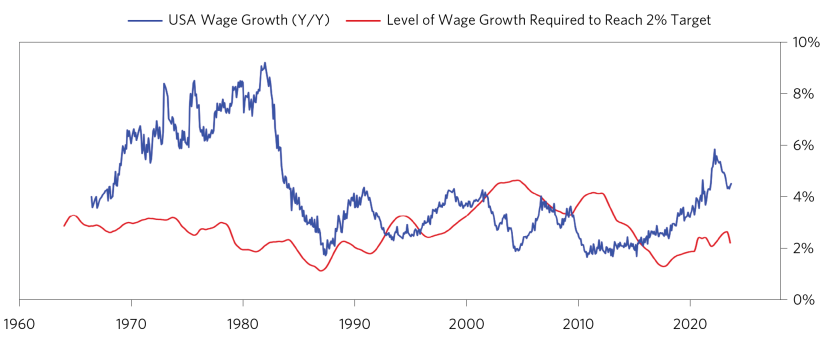
As shown in the chart below, the difference between actual wage growth and this “equilibrium” level is a good indicator of the degree to which inflation deviates from target. Of course, there are other influences that can cause inflation to deviate from this, such as changes to the savings rate and secular forces like globalization making global labor markets factors more important (particularly for tradables), but it serves as a strong anchor for what could be sustainable.
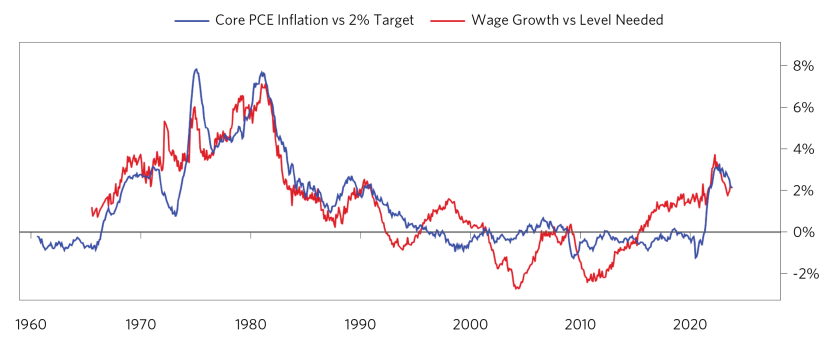
The Level of Nominal Spending Has Cooled but Is Still Too High
Spending is the driving force of the economy, as businesses react to the demand they’re seeing through procyclical hiring, firing, and investment decisions, which then feeds back into the economy via incomes. When nominal spending outpaces production, you get inflation. As we have written above, to get inflation to fall, spending needs to cool to a level consistent with the productive capacity of the economy. That level is somewhere in the range of 3-5%, and even though nominal spending has fallen a lot, it is still above that. We get a timely update of nominal spending growth every week from two perspectives, from the spending perspective and from the financing perspective. Both perspectives suggest that nominal growth has been declining since earlier in the year but is currently running at a rate of 5.5-6.5%, which is still too high.
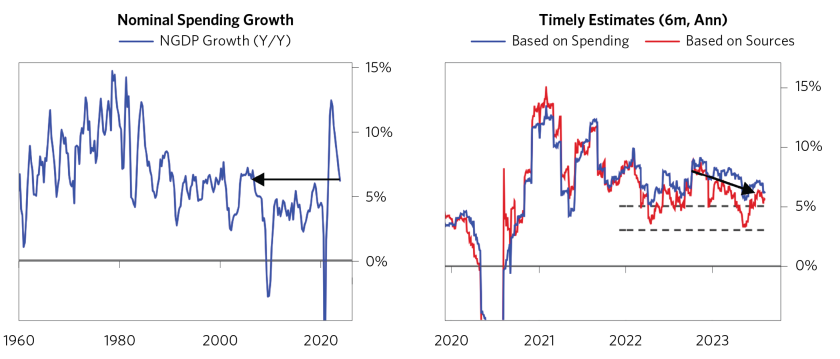
Labor Supply Continues to Be Tight and Unemployment Isn’t Rising
Wages are just a price like any other and are set where the amount of money chasing quantity (demand) meets the amount of quantity offered for that money (supply). We can represent the amount of supply in labor markets by the unemployment rate. After subtracting 6% as a rough center point for the level of unemployment over time, you can see that the level and change in unemployment (the red line, which is inverted and plotted versus zero) are important drivers of wages. This measure is down a bit from the peak but remains a strong upward force on wages—about as strong as ever in the past 50+ years. In order for this quantity influence to be a downward force on wages, you need about a 2% rise in unemployment sustained over a long enough period of time to impact the supply/demand balance for labor.

Typically, changes in the unemployment rate are very closely related to changes in the overall inflation rate. This is because employment growth is a major driver of incomes, which then feeds into spending, and it also serves as a measure of tightening/loosening labor supply, which is a pressure on wages. This relationship is illustrated in the chart below on the left—normally, to get the amount of inflation rate cooling needed to get back to target, we’d need to see a rise in the unemployment rate of about 2%. Zooming in on shorter-term and more timely measures of unemployment rate changes, we don’t see any evidence of a rise at all, as shown in the chart below on the right.
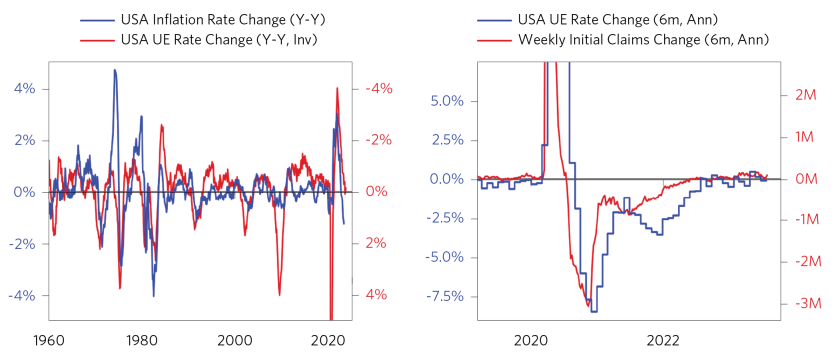
The Level of Spending Is Still Too High Relative to Wages to Compress Labor Margins and Induce Layoffs
When nominal spending growth is high enough such that it outpaces wage growth by an amount that allows for absorbing new workers and maintaining the existing capital stock, margins can grow and businesses are incentivized to hire. When this occurs, labor markets can remain tight, and wages can stay high or rise, which keeps income growth high and further supports spending, a self-reinforcing cycle. This relationship is shown in the charts below, with the one on the left showing the long-term relationship between wage growth relative to nominal spending, adjusted by 2% to proxy the run-rate hiring and reinvestment needed for the economy to grow at potential. The difference between the two represents the incentive businesses face for further hiring and raising wages while maintaining profit growth. The chart on the right shows a timely read of nominal spending growth, which has shown meaningful cooling since the middle of last year but is still at a level that is consistent with profits being maintained.
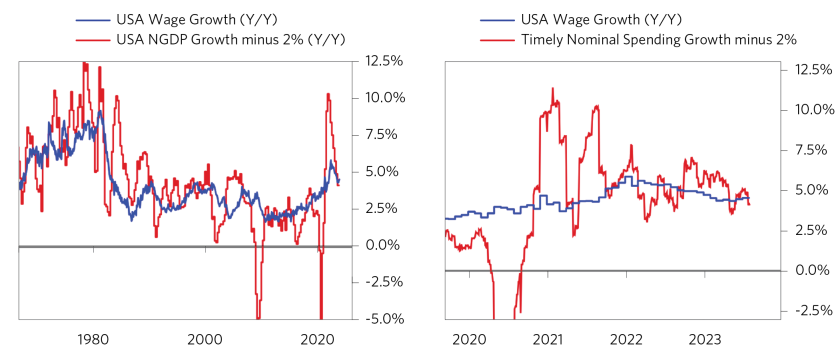
Businesses Are No Longer Being Squeezed like They Were Earlier in the Year, Making It Unlikely They Will Cool the Labor Market
Tightening usually flows through the economy by making credit more expensive and savings more desirable, reducing demand, which then leads to falling profits. Businesses then respond to this weaker demand and drop in net income by cutting labor costs and firing workers, which then lowers household incomes and reduces spending further, a self-reinforcing cycle that cools inflation and the labor market. This is illustrated in the chart below—roughly a 20% drop in earnings would lead to layoffs of the size needed for a rise in the unemployment rate of about 2%.
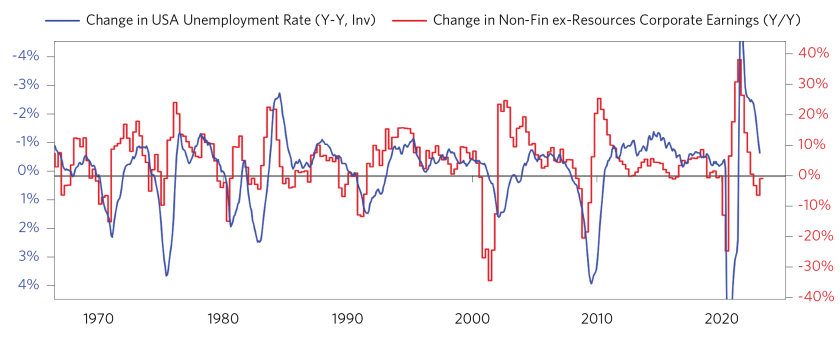
So far, the tightening has failed to bring down (1) nominal spending by enough to hurt corporate profits and (2) access to financing by enough to prompt a labor market contraction. Despite a squeeze earlier in the year, both profits and business borrowing have bounced recently and are no longer contractionary. As shown in the charts below, more recently, profits have been picking back up and the sharp drop in borrowing during the initial stages of the banking crisis has entirely reversed. With the recent squeeze fading, it’s unlikely that businesses will now start firing workers at the rate needed to soften the labor market.
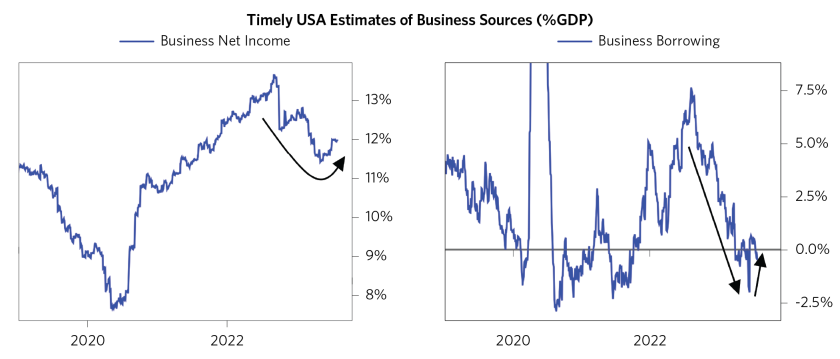
As another point of triangulation on conditions facing businesses, we show below an estimate of listed company profits based on a combination of weekly surveys about their revenues and margins and timely economic stat releases. Over time, this estimate has been reliable at tracking listed EPS growth and, more recently, has been indicating stronger earnings growth.
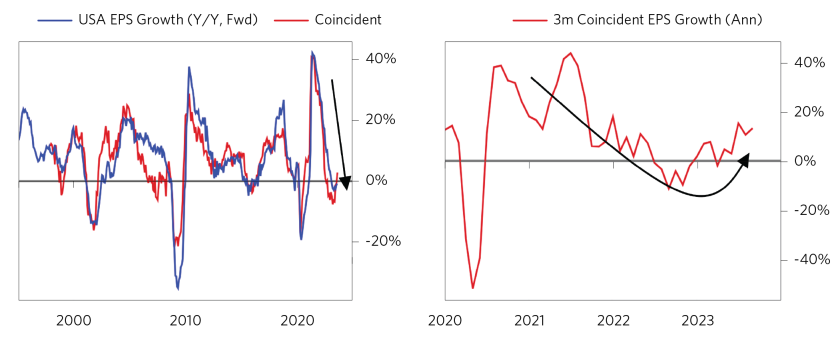
This set of conditions facing businesses is consistent with a continued cooling of labor demand from the very elevated levels of early 2022, but not enough to continue to drive a pickup in the layoffs as we were seeing earlier this year. This is illustrated in charts below—while job openings have continued to fall over the past few months, they’re still at very high levels (left chart), and the amount of layoffs has fallen back close to the historically low levels of last year. Both of these business labor demand measures indicate that the level of wage growth will continue to stay elevated.
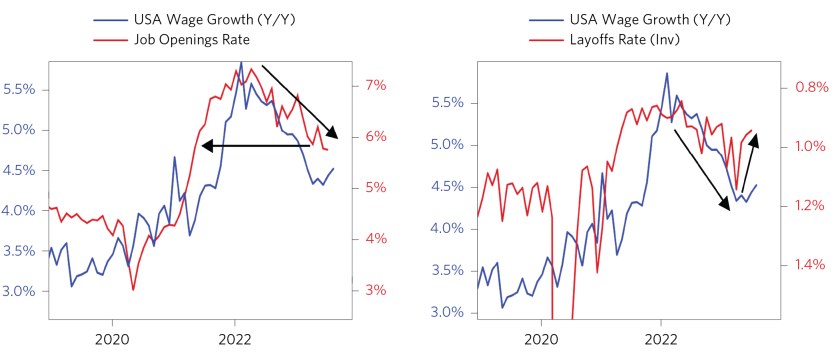
Without a further squeezing of businesses to cool labor demand to a much greater degree, in the face of very tight labor supply, it is very unlikely that we’ll see wage growth fall to the level needed for a 2% inflation rate.
Inflation Estimates Suggest Leveling Out Around Current Levels
As we stare at these markers, it increasingly looks like not enough has been done to bring inflation all the way down to the 2% target, absent a weaker economy. Instead, we’re more likely to see inflation level out at its current rate rather than continue to decline like it has over the past year, as shown in the chart below on the left. This would push the Fed to continue tightening and, with a short pause and return toward easing being priced in, could come through the form of either rate rises or holding rates at high levels, as shown in the chart on the right. This makes assets especially vulnerable to another round of tighter policy.
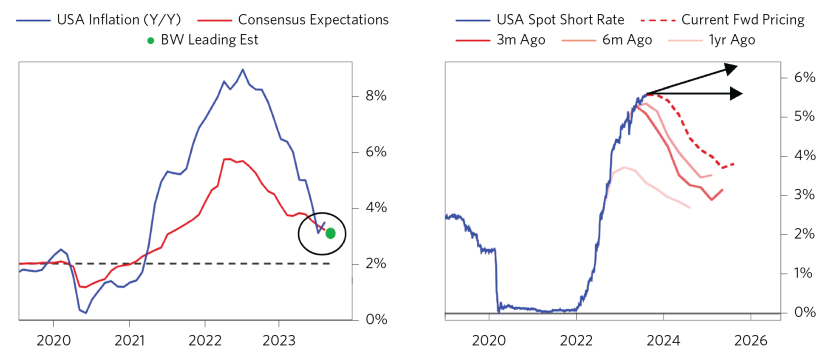
This research paper is prepared by and is the property of Bridgewater Associates, LP and is circulated for informational and educational purposes only. There is no consideration given to the specific investment needs, objectives, or tolerances of any of the recipients. Additionally, Bridgewater’s actual investment positions may, and often will, vary from its conclusions discussed herein based on any number of factors, such as client investment restrictions, portfolio rebalancing and transactions costs, among others. Recipients should consult their own advisors, including tax advisors, before making any investment decision. This material is for informational and educational purposes only and is not an offer to sell or the solicitation of an offer to buy the securities or other instruments mentioned. Any such offering will be made pursuant to a definitive offering memorandum. This material does not constitute a personal recommendation or take into account the particular investment objectives, financial situations, or needs of individual investors which are necessary considerations before making any investment decision. Investors should consider whether any advice or recommendation in this research is suitable for their particular circumstances and, where appropriate, seek professional advice, including legal, tax, accounting, investment, or other advice.
The information provided herein is not intended to provide a sufficient basis on which to make an investment decision and investment decisions should not be based on simulated, hypothetical, or illustrative information that have inherent limitations. Unlike an actual performance record simulated or hypothetical results do not represent actual trading or the actual costs of management and may have under or overcompensated for the impact of certain market risk factors. Bridgewater makes no representation that any account will or is likely to achieve returns similar to those shown. The price and value of the investments referred to in this research and the income therefrom may fluctuate. Every investment involves risk and in volatile or uncertain market conditions, significant variations in the value or return on that investment may occur. Investments in hedge funds are complex, speculative and carry a high degree of risk, including the risk of a complete loss of an investor’s entire investment. Past performance is not a guide to future performance, future returns are not guaranteed, and a complete loss of original capital may occur. Certain transactions, including those involving leverage, futures, options, and other derivatives, give rise to substantial risk and are not suitable for all investors. Fluctuations in exchange rates could have material adverse effects on the value or price of, or income derived from, certain investments.
Bridgewater research utilizes data and information from public, private, and internal sources, including data from actual Bridgewater trades. Sources include BCA, Bloomberg Finance L.P., Bond Radar, Candeal, Calderwood, CBRE, Inc., CEIC Data Company Ltd., Clarus Financial Technology, Conference Board of Canada, Consensus Economics Inc., Corelogic, Inc., Cornerstone Macro, Dealogic, DTCC Data Repository, Ecoanalitica, Empirical Research Partners, Entis (Axioma Qontigo), EPFR Global, ESG Book, Eurasia Group, Evercore ISI, FactSet Research Systems, The Financial Times Limited, FINRA, GaveKal Research Ltd., Global Financial Data, Inc., Harvard Business Review, Haver Analytics, Inc., Institutional Shareholder Services (ISS), The Investment Funds Institute of Canada, ICE Data, ICE Derived Data (UK), Investment Company Institute, International Institute of Finance, JP Morgan, JSTA Advisors, MarketAxess, Medley Global Advisors, Metals Focus Ltd, Moody’s ESG Solutions, MSCI, Inc., National Bureau of Economic Research, Organisation for Economic Cooperation and Development, Pensions & Investments Research Center, Refinitiv, Rhodium Group, RP Data, Rubinson Research, Rystad Energy, S&P Global Market Intelligence, Sentix Gmbh, Shanghai Wind Information, Sustainalytics, Swaps Monitor, Totem Macro, Tradeweb, United Nations, US Department of Commerce, Verisk Maplecroft, Visible Alpha, Wells Bay, Wind Financial Information LLC, Wood Mackenzie Limited, World Bureau of Metal Statistics, World Economic Forum, YieldBook. While we consider information from external sources to be reliable, we do not assume responsibility for its accuracy.
This information is not directed at or intended for distribution to or use by any person or entity located in any jurisdiction where such distribution, publication, availability, or use would be contrary to applicable law or regulation, or which would subject Bridgewater to any registration or licensing requirements within such jurisdiction. No part of this material may be (i) copied, photocopied, or duplicated in any form by any means or (ii) redistributed without the prior written consent of Bridgewater® Associates, LP.
The views expressed herein are solely those of Bridgewater as of the date of this report and are subject to change without notice. Bridgewater may have a significant financial interest in one or more of the positions and/or securities or derivatives discussed. Those responsible for preparing this report receive compensation based upon various factors, including, among other things, the quality of their work and firm revenues.

